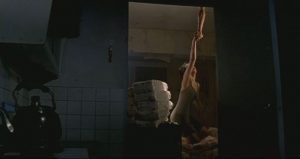
“We become aware of void as we fill it (Porchia, 1943).”
No matter are we glimpsing at, passing through or sheltered by architecture, it is often regarded as nothing as compared to the complexity of life we are housed. However, by breaking the general sensory provoking approach, Andy Warhol presented the 8 hours-movie: Empire (1964) to film stationary skyscraper with the juxtaposition of variance brought by time. As the building takes the lead throughout the movie, it brings touchable urban movement and subtle climate changes to the front. Though qualification of Empire as a movie was in question, it is undeniable that Warhol has successfully offered time for tangible architecture to speak for itself, making it a protagonist.
How can this lifeless construction offer human touch, the essence of movie as entertainment specifically produced for human, then? As I continued reading, although the writer mentioned various themes like sex, sleep and haircut in Warhol’s production, it seems to me that the static quality of architecture has been conceptualized and integrated to his filming style. Given tremendous similar images of the same subject doing the same activity are “unceasingly” played, the impression of those daily experience would gradually root in the minds of the audience. His insistence in the lengthy movie somehow also allows repetition to amplify boredom, which may turn out become intriguing to the ones who can relate to their routine trivial moments. While a movie is supposed to be a series of movement which makes it different from a photograph, the monumentality of private time accomplished by Warhol has inspired filmmakers like Tsai Ming Liang to capture sensational subject “architecturally”. Given the prerequisite of treating those repetitions as iteration is sitting there all day long just to watch a plotless film, I cannot but wonder why can such tedious movies survive and even be imitated? Are they only the artists’ cup of tea?
I can only get a subtle answer for the above question in Tsai’s Hole (1998) as it impressed me by visualizing the concept of void, where architecture meets emotional hollowness. Architecturally speaking, the hole in this movie is literally an empty space that several lonely characters try to fix. Emotionally speaking, “Holes are always there. One can never really fill them in and perhaps should not even try, for one never knows what is actually hidden in a hole.” Would it be relatable to your situation now? Living monotonous days week by week, completing this, fulfilling that and eventually, you are used to the action of not thinking too much even though you may never consider the intention of each of your positions carefully. You dare not explore that emptiness in your soul in order to adapt to the city’s speed. Emptiness never absents from then to now, but perceptions over everyday experience should often be reflected, if not challenged. This is where the affection of architecture floods in the cinema, at least to me.
Architects are not everywhere, but some poetic meanings of life, similar to the manifestos of design projects, can still be understood through reel time filming.
By Wong Mei Ting 3035481239
It is lovely to read your understanding of Bruno’s “Architecture of Time” along with the analysis of Tsai ‘s Hole (1998). You have raised a great point of architecture being the protagonist of film as it gets narrated through time. At the same time, the director has created a very strong emotional linkage with the architecture, the hole, then I wonder how can one film show multiple memories towards one architecture. Great work!